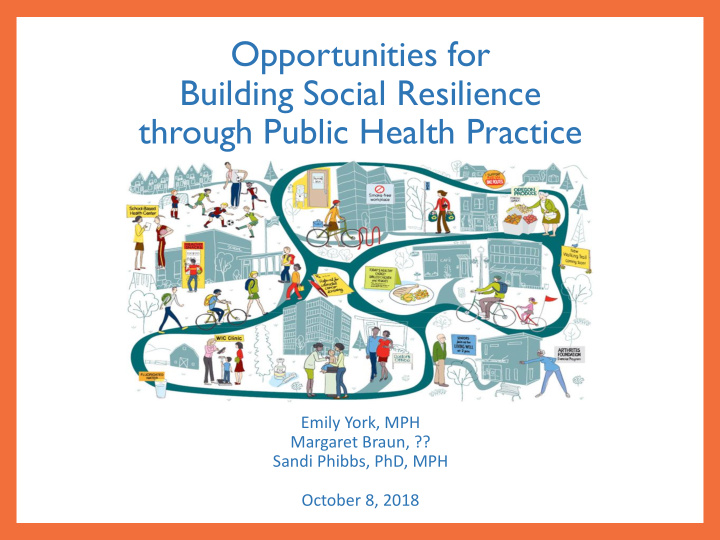



Opportunities for Building Social Resilience through Public Health Practice Emily York, MPH Margaret Braun, ?? Sandi Phibbs, PhD, MPH October 8, 2018
Indicators of Social Resilience to Climate Change Literature review Bottom up: Classic literature in sociology and social and - community psychology Top down: Recent disaster/preparedness literature, non-refereed - articles and project-specific reports Annotated bibliography “Menu” of indicator categories, measures, and potential data sources
About the survey In October of 2017 we surveyed state and local health department employees about: Their knowledge of social cohesion as a concept • • Strategies for building social cohesion Perceived barriers and training needs for building social • cohesion as a public health strategy We received 197 usable responses. The survey contained both closed- ended and open-ended questions. Responses to closed-ended questions were tabulated. Responses to open-ended questions were coded thematically.
In the section below, please identify up to 3 public health strategies for strengthening or building social cohesion within the communities you serve, either directly or indirectly. (Your responses may include strategies you have used or that you know of.) Then, using the sliding scale (with 0=no confidence and 100=high confidence), indicate your confidence in your ability to use each strategy. 0 10 20 30 40 50 60 70 80 90 100 Strategy 1 Strategy 2 Strategy 3
Confidence Confidence Strategy Times Identified Range (0-100) Mean, SD Building coalitions, partnerships, and community 27 15-100 73.6, 23.5 collaborations Communication, Media campaigns 19 1-100 58.3, 25.3 Activities to reduce disparities or improve equity 14 21-100 69.9, 25.4 Input from community (e.g., community forums; 13 3-100 47.3, 32.7 dialogue session with community members) Participating or hosting community events or 12 5-100 62.3, 28.3 activities Don’t Know 10 Disaster or Emergency Preparedness 8 1-100 57.8, 38.3 Assessment, data collection or monitoring 8 50-81 68.8, 12.0 Collective Action 4 81-100 88.7, 10.0 Building capacity or local leadership development 2 11-38 24.5, 19.1
Time, training, and management approval. Barriers Lack of financial and staff resources, lack of capacity. We could do a lot more but there's neither • Lack of funding funding nor staff . . . Barriers include the bureaucracy in • Lack of time which stops us from being able to take off with great ideas. • Constraining Structures • Need for data/information I am not knowledgeable about evidence-based public health • Administrative prioritization programs to build social cohesion • Lack of equity Administrative buy in. These things and relationships take time that is not directly measurable. I feel that the voices of our more vulnerable populations are sometimes not heard or brought to the table. I am not sure if we are really getting to the heart of peoples health concerns or are finding effective ways to improve the health of all people in an empowering way.
Resources & Training Resources Generally Requested Training Generally Requested • Funding (10) • Equity (9) • Communication (3) • Social cohesion (9) • Data (3) • Prioritization (6) • Time (3) • Outreach (4) • Outreach (2) • Data (2) • Innovation (1) • Communication (1) “I think training is needed to define more specific goals that if achieved will directly result in more social cohesion. I also think employees need training to figure out how they will incorporate these goals into their daily routines and activities.”
Emily York: Emily.A.York@state.or.us Margaret Braun: Margaret.Braun@state.or.us Sandi Phibbs: sandi.cleveland@oregonstate.edu
Recommend
More recommend